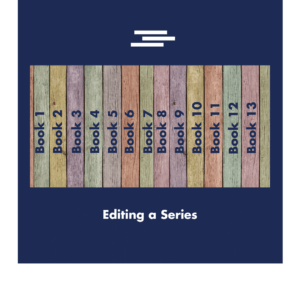
Performing a story edit on a series is more complex than editing a stand-alone novel. For those of you not familiar with the term story edit, it is similar to a structural edit on long-form fiction.
It’s flattering and an honor when a writer asks an editor to edit a second, third or even fourth book. This shows you the writer loves your work. Now that you feel great, let’s cover what is means to edit a series.
First you’ll need a method to keep track of each story. It’s hard to remember previous stories if too much time has passed. I have clients who took a year to write the next book in the series. That’s a long time to remember the details of a story. You probably don’t have the time to go back and re-read the previous stories, but you do owe it to the writer to know if the new book works in the context of the previous books.
So how do you do this?
Before you start, you’ll need more information from a writer than you would for a stand-alone novel.
Ask the writer for:
- The blurb for the new book and for the previous books. You must know the intent of each book AND the intent of the series. Check out Why Does a Story Editor Need a Blurb? to find out how a blurb helps you.
- The synopsis of the previous books. I don’t recommend reading a synopsis of the book you haven’t edited, as you won’t be able to react to twists naturally.
- The final versions of the previous books for reference. What you edited could be very different the final version.
- A list of the Inciting Incident, Plot Point 1, Midpoint, Plot Point 2 and the Climax of the previous books. This will help you address the overall story arc for the series. After your precious edits, this should be easy for the writer to give you since you would have pointed out what those scenes were.
Additional Editor Responsibilities
Novel Endings:
You must go back and reread the ending of the previous book. Then ask yourself:
- Does the opening of the next book flow from the ending of the previous book? You can think of this in the same way as you would when you ask yourself if one scene flows to another.
- Did the resolution of the previous books give a hook to the following book?
- Does the resolution of the current book give a hook if there is another book coming after this one?
Backstory:
You’ll know if the backstory is from a previous book in the series or from before the series began. As the editor, check the backstory in new book is consistent with the backstory in the previous books.
If you’ve used StoryCoach software, you can check this quickly by looking at the Story Map insight and displaying the Backstory. I like to display the scene name too because it helps me remember what the scene is about.

Character Descriptions:
The description of each character who appears in more than one novel must be consistent.
If you have edited in StoryCoach, you can easily compare the edits and refer back to characters who were introduced in a previous book in the series. All you have to do is look at the first scene a character appears on the Cast of Characters page and review the description.
Story Arc:
Once you’ve completed the story edit on the series, check out each Story Arc, and then look at the overall Story Arc.
You’ll need method to keep track of all of the stories in the series along with their key scenes. I edit in StoryCoach software, so I can access my previous edits and review them quickly while I’m editing the current book.
Special StoryCoach Certification Offer
A Fictionary StoryCoach helps writers tell a powerful story and makes the writer’s voice shine! You can now try Fictionary StoryCoach for professional editors for free for one month!
And there’s more. The Fictionary Certified StoryCoach training is available.
Do you want to become a Fictionary Certified StoryCoach? Check out Fictionary Certified StoryCoach Training.
The Fictionary Certified StoryCoach Training program helps editors deliver a comprehensive and objective editorial package using StoryCoach software.
Normal pricing for certification and StoryCoach software:
- $1999 USD for certification
- $468 for an Annual StoryCoach subscription plus $99 per manuscript edited.
To encourage people to get certified, we’re offering the following:
- $468 USD for certification
- An Annual StoryCoach subscription for free plus $99 per manuscript edited.
- $99 per manuscript edited.
This means you’re essentially getting the certification for free as we’ve included a year of StoryCoach. Offer valid until Feb28, 2021. Use coupon code AWESOMECERT
We developed certification training for three reasons.
- The first is for fiction editors to have a place to learn how to perform a high-quality story edit, get certified, and then have a tool (StoryCoach) that helps them perform exceptional story edits.
- To give an editor the opportunity to edit a full-length novel and put that on their resume.
- The third is for writers to know they are dealing with a professional editor who understands story when they hire a Fictionary Certified StoryCoach.


